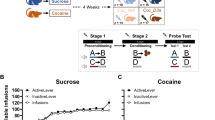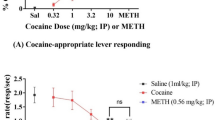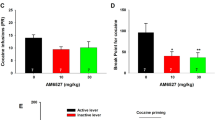Abstract
Despite the prevalent worldwide abuse of stimulants, such as amphetamines and cocaine, no medications are currently approved for treating this serious public health problem. Both preclinical and clinical studies suggest that the opioid antagonist naltrexone (NTX) is effective in reducing the abuse liability of amphetamine, raising the question of whether similar positive findings would be obtained for cocaine. The purpose of this study was to evaluate the ability of oral NTX to alter the cardiovascular and subjective effects of D-amphetamine (D-AMPH) and cocaine (COC). Non-treatment-seeking COC users (N=12) completed this 3-week inpatient, randomized, crossover study. Participants received 0, 12.5, or 50 mg oral NTX 60 min before active or placebo stimulant administration during 10 separate laboratory sessions. Oral AMPH (0, 10, and 20 mg; or all placebo) was administered in ascending order within a laboratory session using a 60-min interdose interval. Smoked COC (0, 12.5, 25, and 50 mg; or all placebo) was administered in ascending order within a laboratory session using a 14-min interdose interval. Active COC and AMPH produced dose-related increases in cardiovascular function that were of comparable magnitude. In contrast, COC, but not AMPH, produced dose-related increases in several subjective measures of positive drug effect (eg, high, liking, and willingness to pay for the drug). NTX did not alter the cardiovascular effects of AMPH or COC. NTX also did not alter positive subjective ratings after COC administration, but it did significantly reduce ratings of craving for COC and tobacco during COC sessions. These results show that (1) oral AMPH produces minimal abuse-related subjective responses in COC smokers, and (2) NTX reduces craving for COC and tobacco during COC sessions. Future studies should continue to evaluate NTX as a potential anti-craving medication for COC dependence.
Similar content being viewed by others
Log in or create a free account to read this content
Gain free access to this article, as well as selected content from this journal and more on nature.com
or
References
Acheson A, de Wit H (2008). Buproprion improves attention but does not affect impulsive behavior in healthy young adults. Exp Clin Psychopharmacol 16: 113–123.
Brauer LH, Ambre J, de Wit H (1996). Acute tolerance to subjective but not cardiovascular effects of d-amphetamine in normal, healthy men. J Clin Psychopharmacol 16: 72–76.
Burattini C, Burbassi S, Aicardi G, Cervo L (2008). Effects of naltrexone on cocaine- and sucrose-seeking behaviour in response to associated stimuli in rats. Int J Neurospychopharmacol 11: 103–109.
Carroll ME, Lac ST, Walker MJ, Kragh R, Newman T (1986). Effects of naltrexone on intravenous cocaine self-administration in rats during food satiation and deprivation. J Pharmacol Exp Ther 238: 1–7.
Comer SD, Haney M, Foltin RW, Fischman MW (1996). Amphetamine self-administration by humans: modulation by contingencies associated with task performance. Psychopharmacology 127: 39–46.
Comer SD, Lac ST, Curtis LK, Carroll ME (1993). Effects of buprenorphine and naltrexone on reinstatement of cocaine-reinforced responding in rats. J Pharmacol Exp Ther 267: 1470–1477.
Comer SD, Sullivan MA, Yu E, Rothenberg JL, Kleber HD, Kampman K et al (2006). Injectable, sustained-release naltrexone for the treatment of opioid dependence: a randomized, placebo-controlled trial. Arch Gen Psychiatry 63: 210–218.
Corrigall WA, Coen KM (1991). Opiate antagonists reduce cocaine but not nicotine self-administration. Psychopharmacology 104: 167–170.
DeFulio A, Everly JJ, Leoutsakos JMS, Umbricht A, Fingerhood M, Bigelow GE et al (2012). Employment-based reinforcement of adherence to an FDA approved extended release formulation of naltrexone in opioid-dependent adults: a randomized controlled trial. Drug Alcohol Depend 120: 48–54.
Dunn KE, Defulio A, Everly JJ, Donlin WD, Aklin WM, Nuzzo PA et al (2012). Employment-based reinforcement of adherence to oral naltrexone treatment in unemployed injection drug users. Exp Clin Psychopharmacol 21: 74–83.
Epstein DH, Marrone GF, Heishman SJ, Schmittner J, Preston KL (2010). Tobacco, cocaine, and heroin: Craving and use during daily life. Addictive Behav 35: 318–324.
Ettenberg A, Pettit HO, Bloom FE, Koob GF (1982). Heroin and cocaine intravenous self-administration in rats: mediation by separate neural systems. Pharmacology 78: 204–209.
Fillmore MT, Rush CR, Abroms BD (2005). D-amphetamine-induced enhancement of inhibitory mechanisms involved in visual search. Exp Clin Psychopharmacol 13: 200–208.
Fillmore MT, Rush CR, Marczinski CA (2003). Effects of d-amphetamine on behavioral control in stimulant abusers: the role of prepotent response tendencies. Drug Alcohol Depend 71: 143–152.
Foltin RW, Ward AS, Haney M, Hart CL, Collins ED (2003). The effects of escalating doses of smoked cocaine in humans. Drug Alcohol Depend 70: 149–157.
Gerrits MAFM, Kuzmin AV, van Ree JM (2005). Reinstatement of cocaine-seeking behavior in rats is attenuated following repeated treatment with the opioid receptor antagonist naltrexone. Eur Neuropsychopharmacol 15: 297–303.
Giuliano C, Robbins TW, Wille DR, Bullmore ET, Everritt BJ (2013). Attenuation of cocaine and heroin seeking by μ-opioid receptor antagonism. Psychopharmacology 227: 137–147.
Grabowski J, Shearer J, Merrill J, Negus SS (2004). Agonist-like, replacement pharmacotherapy for stimulant abuse and dependence. Addict Behav 29: 1439–1464.
Guy W, Wilson WH, Brooking B, Manov G, Fjetland O (1986). Reliability and validity of SAFTEE: preliminary analyses. Psychopharmacol Bull 22: 397–401.
Haggkvist J, Lindholm S, Frank J (2009). The effect of naltrexone on amphetamine-induced conditioned place preference and locomotor behaviour in the rat. Addict Biol 14: 260–269.
Hersh D, Van Kirk JR, Kranzler HR (1998). Naltrexone treatment of comorbid alcohol and cocaine use disorders. Psychopharmacology 139: 44–52.
Jayaram-Lindstrom N, Hammarberg A, Beck O, Franck J (2008a). Naltrexone for the treatment of amphetamine dependence: a randomized, placebo-controlled trial. Am J Psychiatry 165: 1442–1448.
Jayaram-Lindstrom N, Konstenius M, Eksborg S, Beck O, Hammarberg A, Franck J (2008b). Naltrexone attenuates the subjective effects of amphetamine in patients with amphetamine dependence. Neuropsychopharmacology 33: 1856–1863.
Jayaram-Lindstrom N, Wennberg P, Hurd YL, Franck J (2004). Effects of naltrexone on the subjective response to ampthetamine in healthy volunteers. J Clin Psychopharmacol 24: 665–669.
Jimenez-Gomez C, Winger G, Dean RL, Deaver DR, Woods JH (2011). Naltrexone decreases d-amphetamine and ethanol self-administration in rhesus monkeys. Behav Pharmacol 22: 87–90.
King AC, Meyer PJ (2000). Naltrexone alteration of acute smoking response in nicotine-dependent subjects. Pharmacol Biochem Behav 66: 563–572.
Kosten TR, Kleber HD, Morgan C (1989). Role of opioid antagonists in treating intravenous cocaine abuse. Life Sci 44: 887–892.
Kosten T, Silverman DG, Fleming J, Kosten TA, Gawin FH, Compton M et al (1992). Intravenous cocaine challenges during naltrexone maintenance: a preliminary study. Biol Psychiatry 32: 543–548.
Mariani JJ, Levin FR (2012). Psychostimulant treatment of cocaine dependence. Psychiatr Clin North Am 35: 425–439.
Martinez D, Narendran R, Foltin RW, Slifstein M, Hwang DR, Broft A et al (2007). Amphetamine-induced dopamine release: markedly blunted in cocaine dependence and predictive of the choice to self-administer cocaine. Am J Psychiatry 164: 622–629.
McCaul ME, Svikis DS (1996). Measures of service utilization. NIDA Res Monogr 166: 225–241.
Mello NK, Negus SS, Lukas SE, Mendelson JH, Sholar JW, Drieze J (1995). A primate model of polydrug abuse: cocaine and heroin combinations. J Pharmacol Exp Ther 274: 1325–1337.
Meyer MC, Straughn AB, Man-Wai L, Schary WL, Whitney CC (1984). Bioequivalence, dose-proportionality, and pharmacokinetics of naltrexone after oral administration. J Clin Psychiatry 45: 15–19.
Oslin DW, Pettinati HM, Volpicello JR, Wolf AL, Kampman KM, O’Brien CP (1999). The effects of naltrexone on alcohol and cocaine use in dually addicted patients. J Subst Abuse Treat 16: 163–167.
Paliwal P, Hyman SM, Sinha R (2008). Craving predicts time to cocaine relapse: Further validation of the Now and Brief versions of the cocaine craving questionnaire. Drug Alcohol Depend 93: 252–259.
Rabkin JG, Markowitz JS (1986). Side effect assessment with SAFTEE: pilot study of the instrument. Psychopharmacol Bull 22: 389–396.
Ramsey NF, van Ree JM (1991). Intracerebroventricular naltrexone treatment attenuates acquisition of intravenous cocaine self-administration in rats. Pharmacol Biochem Behav 40: 807–810.
Reed SC, Evans SM (2010). The effects of oral d-amphetamine on impulsivity, mood and performance in smoked cocaine users [abstract]. In College on Problems of Drug Dependence. 2010 June 12–17. Scottsdale, Arizona. CPDD; 2010. p 136. Abstract nr 542.
Schmitz JM, Lindsay JA, Green CE, Herin DV, Stotts AL, Moeller FG (2009). High-dose naltrexone therapy for cocaine-alcohol dependence. Am J Addiction 18: 356–362.
Schmitz JM, Stotts AL, Rhoades HM, Grabowski J (2001). Naltrexone and relapse prevention treatment for cocaine-dependent patients. Addict Behav 26: 167–180.
Sevak RJ, Stoops WW, Glaser PEA, Hays LR, Rush CR (2010). Reinforcing effects of d-amphetamine: influence of novel ratios on a progressive-ratio schedule. Behav Pharmacol 21: 745–753.
Sofuoglu M, Singha A, Kosten TR, McCance-Katz FE, Petrakis I, Oliveto A (2003). Effects of naltrexone and isradipine, alone or in combination, on cocaine responses in humans. Pharmacol Biochem Behav 75: 801–808.
Stewart J (1984). Reinstatement of heroin and cocaine self-administration behavior in the rat by intracerebral application of morphine in the ventral tegmental area. Pharmacol Biochem Behav 20: 917–923.
Stoops WW, Glaser PEA, Fillmore MT, Rush CR (2004). Reinforcing, subject-rated, performance and physiological effects of methylphenidate and d-amphetamine in stimulant abusing humans. J Psychopharmacol 18: 534–543.
Stoops WW, Vansickel AR, Lile JA, Rush CR (2007). Acute d-amphetamine pretreatment does not alter stimulant self-administration in humans. Pharmacol Biochem Behav 87: 20–29.
Substance Abuse and Mental Health Services Administration, Center for Behavioral Health Statistics and Quality (2012) The DAWN Report: Highlights of the 2010 Drug Abuse Warning Network (DAWN) Findings on Drug-Related Emergency Department Visits. Rockville, MD, USA.
Substance Abuse and Mental Health Services Administration (2012) Results from the 2011 National Survey on Drug Use and Health: Summary of National Findings NSDUH Series H-44, HHS Publication No. (SMA) 12-4713 Substance Abuse and Mental Health Services Administration, 2012: Rockville, MD, USA.
Todtenkopf MS, O’Neill KS, Kriksciukaite K, Turncliff RZ, Dean RL, Ostrovsky-Day I et al (2009). Route of administration affects the ability of naltrexone to reduce amphetamine-potentiated brain stimulation reward in rats. Addict Biol 14: 408–418.
United Nations Office on Drugs and Crime, World Drug Report (2011). United Nations Publication, Sales No. E. 10. XI. 13.
Volpicelli JR, Alterman AI, Hayashida M, O'Brien CP (1992). Naltrexone in the treatment of alcohol dependence. Arch Gen Psychiatry 49: 876–880.
Wall ME, Brine DR, Perez-Reyes M (1981). Metabolism and disposition of naltrexone in man after oral and intravenous administration. Drug Metab Disposition 9: 369–375.
Walsh SL, Sullivan JT, Preston KL, Garner JE, Bigelow GE (1996). Effects of naltrexone on response to intravenous cocaine, hydromorphone and their combination in humans. J Pharmacol Exp Ther 279: 524–538.
Winger G, Skjoldager P, Woods JH (1992). Effects of buprenorphine and other opioid agonists and antagonists on alfentanil- and cocaine-reinforced responding in rhesus monkeys. J Pharmacol Exp Ther 261: 311–317.
Acknowledgements
We thank Drs Elias Dakwar, Abigail Herron, Nasir Naqvi, Rajkumar Kalapatapu, Taoi Huynh, and Alicia Murray for providing medical coverage during laboratory sessions and participant screening. In addition, we thank Janet Murray, RN and Claudia Tindall, RN, NP for providing nursing support during the study. The authors gratefully acknowledge NIDA for providing funding for this study (DA022222). NIDA had no role in study design or in the decision to submit the paper for publication. NIDA also had no role in the collection, analysis and interpretation of data in the writing of this report.
AUTHOR CONTRIBUTIONS
SD Comer, RW Foltin, and M Haney designed the study. SD Comer, S Mogali, A Pines, and EL Berkower wrote sections of the paper. PA Saccone and P Askalsky collected data and provided preliminary statistical analyses of the results. S Mogali, D Martinez, E Rubin, MA Sullivan, and JM Manubay provided medical coverage and/or medical advice during the study. SD Comer, ZD Cooper, JD Jones, P Roux, EA Walker, and SK Vosburg interviewed potential participants and supervised data collection. All of the co-authors read a draft of the paper.
Author information
Authors and Affiliations
Corresponding author
Additional information
Portions of these data were presented at the 2011 and 2012 meetings of the College on Problems of Drug Dependence, as well as the 2011 meeting of the Colloque Europeen et International Toxicomanies Hepatites SIDA
Rights and permissions
About this article
Cite this article
Comer, S., Mogali, S., Saccone, P. et al. Effects of Acute Oral Naltrexone on the Subjective and Physiological Effects of Oral D-Amphetamine and Smoked Cocaine in Cocaine Abusers. Neuropsychopharmacol 38, 2427–2438 (2013). https://doi.org/10.1038/npp.2013.143
Received:
Revised:
Accepted:
Published:
Issue date:
DOI: https://doi.org/10.1038/npp.2013.143
Keywords
This article is cited by
-
Development of the Neuroimmune Modulator Ibudilast for the Treatment of Alcoholism: A Randomized, Placebo-Controlled, Human Laboratory Trial
Neuropsychopharmacology (2017)
-
Naltrexone modulates dopamine release following chronic, but not acute amphetamine administration: a translational study
Translational Psychiatry (2017)
-
Naltrexone moderates the relationship between cue-induced craving and subjective response to methamphetamine in individuals with methamphetamine use disorder
Psychopharmacology (2017)
-
Safety and tolerability of intranasal cocaine during phendimetrazine maintenance
Psychopharmacology (2016)
-
Agonist Medications for the Treatment of Cocaine Use Disorder
Neuropsychopharmacology (2015)



